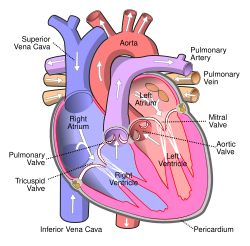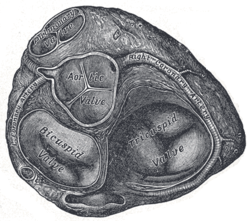Tricuspid valves
| Tricuspid valve | |
|---|---|

Anterior (frontal) view of the opened heart. White arrows indicate normal blood flow. (Tricuspid valve labeled at bottom left.)
|
|

Base of ventricles exposed by removal of the atria. (Tricuspid valve visible at bottom right.)
|
|
| Details | |
| Identifiers | |
| Latin | Valvula tricuspidalis, valva atrioventricularis dextra |
| MeSH | A07.541.510.893 |
| Dorlands /Elsevier |
12843894 |
| TA | A12.1.02.003 |
| FMA | 7234 |
|
Anatomical terminology
[]
|
|
The tricuspid valve, or right atrioventricular valve, is on the right dorsal side of the mammalian heart, between the right atrium and the right ventricle. The function of the valve is to prevent back flow of blood into the right atrium.
The normal tricuspid valve usually has three leaflets and three papillary muscles. They are connected to the papillary muscles by the chordae tendineae, which lie in the right ventricle. Tricuspid valves may also occur with two or four leaflets; the number may change over a lifetime.
The tricuspid valve prevents back flow of blood from the right ventricle into the right atrium during ventricular systole when the valve closes and allows blood to flow from right atrium into right ventricle during ventricular diastole when it opens. This valve is weakened by drug abuse, and can lead to heart failure through the back flow of blood. The back flow of blood is also known as regression or tricuspid regurgitation.
Tricuspid regurgitation is not uncommon.
Infected valves can result in endocarditis in intravenous drug users. Patients who inject narcotics or other drugs intravenously may introduce infection, which can travel to the right side of the heart, most often caused by the bacteria S. aureus. In patients without a history of intravenous exposure, endocarditis is more frequently left-sided.
The tricuspid valve can be affected by rheumatic fever, which can cause tricuspid stenosis or tricuspid insufficiency (also called tricuspid regurgitation). Some individuals are born with congenital abnormalities of the tricuspid valve. Congenital apical displacement of the tricuspid valve is called Ebstein's anomaly and typically causes significant tricuspid regurgitation.
...
Wikipedia
